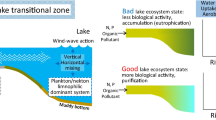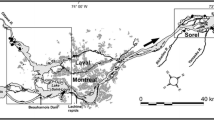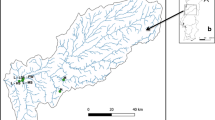Abstract
We tested how ecosystem structure (macroinvertebrate community and primary producers) and functions (leaf decay and open-water metabolism) are related to water quality in the Portneuf River, southeast Idaho. This river is polluted with excess nutrients and fine sediment and simultaneously demonstrates a range of hydrologic conditions due to a variety of groundwater and spring inputs. Macroinvertebrate abundance, functional feeding group composition, and diversity responded most to hydrology due to affinity of the invasive New Zealand mudsnail for spring-influenced conditions. Macrophytes were most abundant at spring-influenced sites, while benthic periphyton standing crop was highest at sites with highest nutrient concentrations. Leaf decay rates increased by 50% at spring-influenced sites and showed no response to 3–100-fold differences in nutrient concentrations. Finally, primary production measured via open-water metabolism was highest at spring-influenced sites, which tended to have low turbidity. Community respiration, however, was greatest at the site with the highest nutrient concentrations. Therefore, open-water metabolism was a useful indicator of water quality in this nutrient-polluted river, while invertebrate community structure and leaf decay did not reflect large differences in water quality among sites. Our findings suggest that structure and function metrics provide complementary information on biotic responses to water pollution and that these metrics should be used in concert to more fully understand and monitor biotic responses to water pollution and hydrologic alterations in streams and rivers.



Similar content being viewed by others
References
American Public Health Association. (2005). Standard methods for the examination of water and wastewater. Washington, DC: American Public Health Association.
Baldwin, J., Wicherski, B., Cody, C., & Taylor, R. (2004). Evaluation of water quality impacts associated with FMC and Simplot phosphate ore processing facilities, Pocatello, Idaho. Boise, ID: Idaho Department of Environmental Quality Technical Services Division.
Barbour, M. T., Gerritsen, J., Snyder, B. D., & Stribling, J. B. (1999). Rapid bioassessment protocols for use in streams and wadeable rivers: periphyton, benthic macroinvertebrates and fish. EPA 841-B-99-002 (2nd ed.). Washington, DC: US Environmental Protection Agency, Office of Water.
Barton, G. J. (2004). Surface- and ground-water relations on the Portneuf River, and temporal changes in ground-water levels in the Portneuf Valley, Caribou and Bannock Counties, Idaho, 2001–02. US Geological Survey Scientific Investigations Report 2004-5170. Reston, VA: US Geological Survey.
Benfield, E. F. (2006). Decomposition of leaf material. In F. R. Hauer & G. A. Lamberti (Eds.), Methods in stream ecology (2nd ed., pp. 711–720). San Diego, CA: Academic.
Bernot, M. J., & Dodds, W. K. (2005). Nitrogen retention, removal, and saturation in lotic ecosystems. Ecosystems, 8, 442–453.
Bott, T. L. (2006). Primary production and community respiration. In F. R. Hauer & G. A. Lamberti (Eds.), Methods in stream ecology (2nd ed., pp. 663–690). San Diego, CA: Academic.
Boulton, A. J., & Boon, P. I. (1991). A review of methodology used to measure leaf litter decomposition in lotic environments: Time to turn over a new leaf? Australian Journal of Marine and Freshwater Research, 42, 1–43.
Brock, J. T., & Ray, A. M. (2004). Quality assurance project plan for the Lower Portneuf River monitoring project. Submitted to US Environmental Protection Agency Region 10 Watershed Restoration Unit, Seattle, WA. Approved 23 July 2004.
Bunn, S. E., & Davies, P. M. (2000). Biological processes in running waters and their implications for the assessment of ecological integrity. Hydrobiologia, 422/423, 61–70.
Bunn, S. E., Davies, P. M., & Mosisch, T. D. (1999). Ecosystem measures of river health and their response to riparian and catchment degradation. Freshwater Biology, 41, 333–345.
Chessman, B., Growns, I., Currey, J., & Plunkett-Cole, N. (1999). Predicting diatom communities at the genus level for the rapid biological assessment of rivers. Freshwater Biology, 41, 317–331.
Dodds, W. K. (2002). Freshwater ecology: Concepts and environmental applications. New York, NY: Academic.
Earl, S. R., Valett, H. M., & Webster, J. R. (2006). Nitrogen saturation in stream ecosystems. Ecology, 87, 3140–3151.
Fellows, C. S., Clapcott, J. E., Udy, J. W., Bunn, S. E., Harch, B. D., Smith, M. J., et al. (2006). Benthic metabolism as an indicator of stream ecosystem health. Hydrobiologia, 572, 71–87.
Gessner, M. O., & Chauvet, E. (2002). A case for using litter breakdown to assess functional stream integrity. Ecological Applications, 12, 498–510.
Greenwood, J. L., & Rosemond, A. D. (2005). Periphyton response to long-term nutrient enrichment in a shaded headwater stream. Canadian Journal of Fisheries and Aquatic Sciences, 62, 2033–2045.
Grimm, N. B., Sheibley, R. W., Crenshaw, C. L., Dahm, C. N., Roach, W. J., & Zeglin, L. H. (2005). N retention and transformation in urban streams. Journal of the North American Benthological Society, 24, 626–642.
Gücker, B., Brauns, M., & Pusch, M. T. (2006). Effects of wastewater treatment plant discharge on ecosystem structure and function of lowland streams. Journal of the North American Benthological Society, 25, 313–329.
Gulis, V., Ferreira, V., & Graca, M. A. S. (2006). Stimulation of leaf litter decomposition and associated fungi and invertebrates by moderate eutrophication: Implications for stream assessment. Freshwater Biology, 51, 1655–1669.
Hagen, E. M., Webster, J. R., & Benfield, E. F. (2006). Are leaf breakdown rates a useful measure of stream integrity along an agricultural landuse gradient? Journal of the North American Benthological Society, 25, 330–343.
Hall, R. O., Tank, J. L., & Dybdahl, M. F. (2003). Exotic snails dominate nitrogen and carbon cycling in a highly productive stream. Frontiers in Ecology and the Environment, 1, 407–411.
Hill, W. R., Ryon, M. G., & Schilling, E. M. (1995). Light limitation in a stream ecosystem: responses by primary producers and consumers. Ecology, 76, 1297–1309.
Hilsenhoff, W. L. (1969). An artificial substrate device for sampling benthic stream invertebrates. Limnology and Oceanography, 14, 465–471.
Hilsenhoff, W. L. (1987). An improved biotic index of organic stream pollution. Great Lakes Entomologist, 20, 31–39.
Hopkins, J. M. (2007). Spatial and temporal evaluation of macroinvertebrate communities in the Portneuf River, Idaho and an inquiry-based field and laboratory exercise on in-stream leaf litter decay. DA Dissertation. Pocatello, ID: Idaho State University.
Hornberger, G. M., & Kelly, M. G. (1975). Atmospheric reaeration in a river using productivity analysis. Journal of the Environmental Engineering Division ASCE, 101, 729–739.
Idaho Division of Environmental Quality. (1999). Portneuf River TMDL: Water body assessment and total maximum daily load. Pocatello, ID: Idaho Department of Environmental Quality.
Iwata, T., Takahashi, T., Kazama, F., Hiraga, Y., Fukuda, N., Honda, M., et al. (2007). Metabolic balance of stream draining urban and agricultural watersheds in central Japan. Limnology, 8, 243–250.
Izagirre, O., Bermejo, M., Pozo, J., & Elosegi, A. (2007). RIVERMET©: An Excel based tool to calculate river metabolism from diel oxygen-concentration curves. Environmental Modelling and Software, 22, 24-32.
Karr, J. R. (1991). Biological integrity: A long-neglected aspect of water resource management. Ecological Applications, 1, 66–84.
Kearns, B. L., Dybdahl, M. F., Gangloff, M. M., & Jannot, J. E. (2005). Potamopyrgus antipodarum: Distribution, density, and effects on native macroinvertebrate assemblages in the Greater Yellowstone Ecosystem. Journal of the North American Benthological Society, 24, 123–138.
Kennard, M. J., Pusey, B. J., Arthington, A. H., Harch, B. D., & MacKay, S. J. (2006). Development and application of a predictive model of freshwater fish assemblage composition to evaluate river heath in eastern Australia. Hydrobiologia, 572, 33–57.
Marcarelli, A. M., Bechtold, H. A., Rugenski, A. T., & Inouye, R. S. (2009). Nutrient limitation of biofilm biomass and metabolism in the Upper Snake River basin, southeast Idaho, USA. Hydrobiologia, 620, 63–76.
Merritt, R. W., & Cummins, K. W. (1996). An introduction to the aquatic insects of North America. Dubuque, IA: Kendall/Hunt.
Meyer, J. L., Paul, M. J., & Taulbee, W. K. (2005). Stream ecosystem function in urbanizing landscapes. Journal of the North American Benthological Society, 24, 602–612.
Minshall, G. W. (1996). Bringing biology back into water quality assessments. In Committee on Inland Aquatic Ecosystems, National Research Council (Ed.), Freshwater ecosystems: Revitalizing educational programs in limnology (pp. 289–324). Washington, DC: National Academies Press.
Minshall, G. W., & Andrews, D. A. (1973). An ecological investigation of the Portneuf River, Idaho: a semiarid-land stream subjected to pollution. Freshwater Biology, 3, 1–30.
Minshall, G. W., Petersen, R. C., Cummins, K., Bott, T. L., Sedell, J. R., Cushing, C. E., et al. (1983). Interbiome comparison of stream ecosystem dynamics. Ecological Monographs, 53, 1–25.
Mulholland, P. J., Fellows, C. S., Tank, J. L., Grimm, N. B., Webster, J. R., Hamilton, S. K., et al. (2001). Inter-biome comparison of factors controlling stream metabolism. Freshwater Biology, 46, 1503–1517.
Mulholland, P. J., Thomas, S. A., Valett, H. M., Webster, J. R., & Beaulieu, J. (2006). Effects of light on NO -3 uptake in small forested streams: diurnal and day-to-day variations. Journal of the North American Benthological Society, 25, 583–595.
Niyogi, D. K., Lewis, W. M., Jr., & McKnight, D. M. (2001). Litter breakdown in mountain streams affected by mine drainage: Biotic mediation of abiotic controls. Ecological Applications, 11, 506–526.
Odum, H. T. (1956). Primary production in flowing waters. Limnology and Oceanography, 1, 102–117.
Pascoal, C., Pinho, M., Cassio, F., & Gomes, P. (2003). Assessing structural and functional ecosystem condition using leaf breakdown: Studies on a polluted river. Freshwater Biology, 48, 2033–2044.
Paul, M. J., Meyer, J. L., & Couch, C. A. (2006). Leaf breakdown in streams differing in catchment land use. Freshwater Biology, 51, 1684–1695.
Plafkin, J. L., Barbour, M. T., Porter, K. D., Gross, S. K., & Hughes, R. M. (1989). Rapid bioassessment protocols for use in streams and rivers: Benthic macroinvertebrates and fish. Washington: US Environmental Protection Agency, Office of Water Regulations and Standards.
Poff, N. L., & Ward, J. V. (1990). Physical habitat template of lotic systems: Recovery in the context of historical pattern of spatiotemporal heterogeneity. Environmental Management, 14, 629–645.
Poff, N. L., Allan, J. D., Bain, M. B., Karr, J. R., Prestegaard, K. L., Richter, B. D., et al. (1997). The natural flow regime. Bioscience, 47, 769–784.
Resh, V. H. (2008). Which group is best? Attributes of different biological assemblages used in freshwater biomonitoring programs. Environmental Monitoring and Assessment, 138, 131–138.
Robinson, C. T., & Gessner, M. O. (2000). Nutrient addition accelerates leaf breakdown in an alpine springbrook. Oecologia, 122, 258–263.
Rosemond, A. D., Mulholland, P. J., & Elwood, J. W. (1993). Top-down and bottom-up control of stream periphyton: effects of nutrients and herbivores. Ecology, 74, 1264–1280.
Rosenberg, D. M., & Resh, V. H. (1993). Introduction to freshwater biomonitoring and benthic macroinvertebrates. London: Chapman & Hall.
Royer, T. V., & Minshall, G. W. (1997). Rapid breakdown of allochthonous and autochthonous plant material in a eutrophic river. Hydrobiologia, 344, 81–86.
Royer, T. V., & Minshall, G. W. (2001). Effects of nutrient enrichment and leaf quality on the breakdown of leaves in a hardwater stream. Freshwater Biology, 46, 603–610.
Sandin, L., & Solimini, A. G. (2009). Freshwater ecosystem structure–function relationships: From theory to application. Freshwater Biology, 54, 2017–2024.
Sponseller, R. A., & Benfield, E. F. (2001). Influences of land use on leaf breakdown in southern Appalachian headwater streams: a multiple-scale analysis. Journal of the North American Benthological Society, 20, 44–59.
Suberkropp, K., & Chauvet, E. (1995). Regulation of leaf breakdown by fungi in streams: Influences of water chemistry. Ecology, 76, 1433–1445.
USEPA. (2007). National section 303(d) list fact sheet. Washington, DC: USEPA. http://oaspub.epa.gov/waters/national_rept.control#TOP_IMP Accessed 2 Jan. 2008.
Vinson, M. (2004). The occurrence and distribution of New Zealand mudsnail (Potamopyrgus antipodarum) in Utah. Salt Lake City: Utah Department of Natural Resources Division of Wildlife Resources.
Von Schiller, D., Martí, E., Riera, J. L., Ribot, M., Marks, J. C., & Sabater, F. (2008). Influence of land use on stream ecosystem function in a Mediterranean catchment. Freshwater Biology, 53, 2600–2612.
Wiggins, G. B. (1996). Larvae of the North American Caddisfly Genera (Trichoptera) (2nd ed.). Toronto: University of Toronto Press.
Young, R. G., & Huryn, A. D. (1999). Effects of land use on stream metabolism and organic matter turnover. Ecological Applications, 9, 1359–1376.
Young, R. G., & Collier, K. J. (2009). Contrasting responses to catchment modification among a range of functional and structural indicators of river ecosystem health. Freshwater Biology, 54, 2155–2170.
Young, R. G., Huryn, A. D., & Townsend, C. R. (1994). Effects of agricultural development on processing of tussock leaf litter in high country New Zealand streams. Freshwater Biology, 32, 413–427.
Young, R. G., Matthaei, C. D., & Townsend, C. R. (2008). Organic matter breakdown and ecosystem metabolism: Functional indicators for assessing river ecosystem health. Journal of the North American Benthological Society, 27, 605–625.
Acknowledgements
This work was funded by the NSF-Idaho EPSCoR program (EPS 04-47689) and the Idaho Department of Environmental Quality (EPA X7-96009701). Collaborators at the Idaho DEQ (G. Mladenka, M. Rowe, and A. Ray) and Idaho State University (R. Inouye, G. W. Minshall, and C. Baxter) provided valuable guidance, discussion, and field assistance for this project. R. Clay, M. Inouye, S. Mathies, M. Mineau, A. Rugenski, A. Ruiz, M. Thompson, and C. Waite provided field and/or lab assistance. J. Anderson provided cartographic services for Fig. 1. An earlier version of this manuscript was improved by reviews from C. Baxter, G. W. Minshall, A. Ray, F. Moore, and one anonymous reviewer. The chemistry and sonde data were collected as part of the Portneuf Basin Monitoring Program and is supported by the Center for Ecological Research and Education at Idaho State University, the City of Pocatello, J. R. Simplot Company, the Portneuf Soil and Water Conservation District, the Shoshone-Bannock Tribes, Three Rivers RC&D Council Inc., the United States Environmental Protection Agency, Rapid Creek Research Inc., and the Idaho Departments of Agriculture, Environmental Quality, and Fish and Game.
Author information
Authors and Affiliations
Corresponding author
Rights and permissions
About this article
Cite this article
Hopkins, J.M., Marcarelli, A.M. & Bechtold, H.A. Ecosystem Structure and Function are Complementary Measures of Water Quality in a Polluted, Spring-Influenced River. Water Air Soil Pollut 214, 409–421 (2011). https://doi.org/10.1007/s11270-010-0432-y
Received:
Accepted:
Published:
Issue Date:
DOI: https://doi.org/10.1007/s11270-010-0432-y




